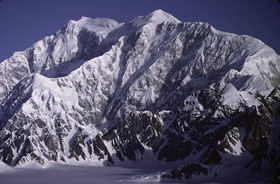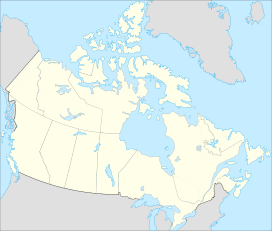Mount Logan
| Mount Logan | |
|---|---|
 Mount Logan from the southwest |
|
| Elevation | 5,959 m (19,551 ft) |
| Prominence | 5,250 m (17,224 ft) [1] Ranked 6th |
| Parent peak | Mount McKinley[2] |
| Listing | Seven Second Summits Country high point List of Ultras in Canada |
| Location | |
 Mount Logan
|
|
| Range | Saint Elias Mountains |
| Topo map | NTS 115B |
| Climbing | |
| First ascent | 1925 by A.H. MacCarthy et al. |
| Easiest route | glacier/snow/ice climb |
Mount Logan is the highest mountain in Canada and the second-highest peak in North America, after Mount McKinley (Denali). The mountain was named after Sir William Edmond Logan, a Canadian geologist and founder of the Geological Survey of Canada (GSC). Mount Logan is located within Kluane National Park and Reserve[3] in southwestern Yukon and is the source of the Hubbard and Logan Glaciers. Logan is believed to have the largest base circumference of any non-volcanic mountain on Earth (a large number of shield volcanoes are much larger in size and mass), with the massif containing eleven peaks over 5,000 metres (16,400 ft).[4][5]
Due to active tectonic uplifting, Mount Logan is still rising in elevation. Before 1992, the exact height of Mount Logan was unknown and measurements ranged from 5,959 metres (19,551 ft) to 6,050 metres (19,849 ft). In May 1992, a GSC expedition climbed Mount Logan and fixed the current height of 5,959 metres (19,551 ft) using GPS.[4]
Temperatures are extremely cold on and near Mount Logan. On the high 5,000 m plateau, air temperature hovers around −45 °C (−49 °F) in the winter and reaches near freezing in summer with the median temperature for the year around −27 °C (−17 °F). A temperature of −77.5 °C (−108 °F) was recorded in 1991, which may be the coldest temperature ever recorded in the northern hemisphere. This is quite controversial due to the high elevation.[6] Minimal snow melt leads to a significant ice cap, reaching almost 300 m (984 ft) in certain spots.[5]
Contents |
Peaks of the massif
The Mount Logan massif is considered to contain all the surrounding peaks with less than 500 m (1,640 ft) of prominence, as listed below:
| Peak | Height | Prominence | coordinates |
|---|---|---|---|
| Main[1] | 5,959 m (19,551 ft) | 5,250 m (17,224 ft) above Mentasta Pass | |
| Philippe Peak (West)[7] | 5,925 m (19,439 ft) | 265 m (869 ft) | |
| Logan East Peak (Stuart Peak)[8] | 5,898 m (19,350 ft) | 198 m (650 ft) | |
| Houston's Peak[9] | 5,740 m (18,832 ft) | 100 m (328 ft) | |
| Prospector Peak[10] | 5,644 m (18,517 ft) | 344 m (1,129 ft) | |
| AINA Peak[11] | 5,630 m (18,471 ft) | 130 m (427 ft) | |
| Russell Peak[12] | 5,580 m (18,307 ft) | 80 m (262 ft) | |
| Tudor Peak (Logan North Peak)[13] | 5,559 m (18,238 ft) | 219 m (719 ft) | |
| Saxon Peak (Northeast)[14] | 5,500 m (18,045 ft) | 80 m (262 ft) | |
| Queen Peak[15] | 5,380 m (17,651 ft) | 160 m (525 ft) | |
| Capet Peak (Northwest)[16] | 5,250 m (17,224 ft) | 240 m (787 ft) | |
| Catenary Peak[17] | 4,097 m (13,442 ft) | 397 m (1,302 ft) | |
| Teddy Peak[18] | 3,956 m (12,979 ft) | 456 m (1,496 ft) |
First ascent
In 1922, a geologist approached the Alpine Club of Canada with the suggestion that the club send a team to the mountain to reach the summit for the first time. An international team of Canadian, British and American climbers was assembled and initially they had planned their attempt in 1924 but funding and preparation delays postponed the trip until 1925. The international team of climbers began their journey in early May, crossing the mainland from the Pacific coast by train. They then walked the remaining 200 kilometres (120 mi) to within 10 kilometres (6 mi) of the Logan Glacier where they established base camp. In the early evening of June 23, 1925, Albert H. MacCarthy (leader), H.F. Lambart, Allen Carpé, W.W. Foster, N. Read and Andy Taylor stood on top for the first time.[5][19] It had taken them 65 days to approach the mountain from the nearest town, McCarthy, summit and return, with all climbers intact.[20]
Subsequent notable ascents
- 1957 East Ridge. Don Monk, Gil Roberts and 3 others (USA) reached the summit on July 19.[21]
- 1965 Hummingbird Ridge (South Ridge). Dick Long, Allen Steck, Jim Wilson, John Evans, Frank Coale and Paul Bacon (USA) over 30 days, mid-July to Mid-August. Fred Beckey remarked: "When they got back we just couldn't believe that they had climbed that thing. We didn't think they had a chance".[22] Featured in Fifty Classic Climbs of North America.
- 1979 Northwest Ridge. Michael Down (CA), Paul Kindree, John Howe, Reid Carter and John Wittmayer climbed to the summit over 22 days, topping out on June 19.[23]
- 1979 South-Southwest Ridge. Raymond Jotterand (CA), Alan Burgess, Jim Elzinga and John Laughlan reached the summit after 15 days of climbing on June 30 and July 1.[24]
Proposed renaming
Following the death of former Prime Minister Pierre Trudeau, Prime Minister Jean Chrétien, a close friend of Trudeau's, considered renaming the mountain Mount Trudeau;[25] [26] however, opposition from Yukoners, mountaineers, geologists, Trudeau's political critics, and many other Canadians forced the plan to be dropped. A mountain in British Columbia's Premier Range was named Mount Pierre Elliott Trudeau instead.
May 2005 rescue
During the last few days of May 2005, three climbers from the North Shore Search and Rescue team of North Vancouver became stranded on the mountain. A joint operation by Canadian and American forces rescued the three climbers and took them to Anchorage, Alaska for treatment of frostbite. There were also climbers on the mountain that were part of the same team who had to abandon their summit bid in order to help rescue their teammates. The main rescue team in the area was, ironically, the team that needed rescuing.[27]
See also
- 4000 metre peaks of Canada
- 4000 metre peaks of North America
- List of highest points of Canadian provinces and territories
- Mountain peaks of Canada
- Mountain peaks of North America
Bibliography
- Irving, R. L. G., Ten Great Mountains (London, J. M. Dent & Sons, 1940)[28]
- Sherman, Paddy (1965). Cloud Walkers - Six Climbs on Major Canadian Peaks. Toronto, Canada: Macmillan of Canada. pp. 1–38. Lib Congress Cat# 65-25069.
- Roper, Steve; Allen Steck (1979). Fifty Classic Climbs of North America. San Francisco, CA, USA: Sierra Club Books. pp. 179–182. ISBN 0-87156-292-8.
References
- ↑ 1.0 1.1 "Mount Logan". Canadian Mountain Encyclopedia. Bivouac.com. http://www.bivouac.com/MtnPg.asp?MtnId=14. Retrieved 2007-07-15.
- ↑ "Mount Logan". Peakbagger.com. http://www.peakbagger.com/peak.aspx?pid=541. Retrieved 2010-08-27.
- ↑ "Kluane National Park and Reserve of Canada". Parks Canada. http://www.pc.gc.ca/pn-np/yt/kluane/index.aspx. Retrieved 2010-08-01.
- ↑ 4.0 4.1 "Mount Logan". Geological Survey of Canada. http://gsc.nrcan.gc.ca/hist/logan/mountlogan_e.php. Retrieved 2007-04-12.
- ↑ 5.0 5.1 5.2 "Mount Logan: Canadian Titan". Virtual Museum of Canada. http://www.virtualmuseum.ca/Exhibitions/Logan/. Retrieved 2008-09-18.
- ↑ "The Yukon - Mt. Logan"
- ↑ "Philippe Peak". Canadian Mountain Encyclopedia. Bivouac.com. http://www.bivouac.com/MtnPg.asp?MtnId=18352. Retrieved 2007-07-15.
- ↑ "Logan East Peak (Stuart Peak)". Canadian Mountain Encyclopedia. Bivouac.com. http://www.bivouac.com/MtnPg.asp?MtnId=15754. Retrieved 2007-07-15.
- ↑ "Houston's Peak". Canadian Mountain Encyclopedia. Bivouac.com. http://www.bivouac.com/MtnPg.asp?MtnId=15875. Retrieved 2007-07-15.
- ↑ "Prospector Peak". Canadian Mountain Encyclopedia. Bivouac.com. http://www.bivouac.com/MtnPg.asp?MtnId=16893. Retrieved 2007-07-15.
- ↑ "AINA Peak". Canadian Mountain Encyclopedia. Bivouac.com. http://www.bivouac.com/MtnPg.asp?MtnId=15003. Retrieved 2007-07-15.
- ↑ "Russell Peak". Canadian Mountain Encyclopedia. Bivouac.com. http://www.bivouac.com/MtnPg.asp?MtnId=16931. Retrieved 2007-07-15.
- ↑ "Tudor Peak (Logan North Peak)". Canadian Mountain Encyclopedia. Bivouac.com. http://www.bivouac.com/MtnPg.asp?MtnId=16708. Retrieved 2007-07-15.
- ↑ "Saxon Peak". Canadian Mountain Encyclopedia. Bivouac.com. http://www.bivouac.com/MtnPg.asp?MtnId=16718. Retrieved 2007-07-15.
- ↑ "Queen Peak". Canadian Mountain Encyclopedia. Bivouac.com. http://www.bivouac.com/MtnPg.asp?MtnId=16897. Retrieved 2007-07-15.
- ↑ "Capet Peak (Northwest Peak)". Canadian Mountain Encyclopedia. Bivouac.com. http://www.bivouac.com/MtnPg.asp?MtnId=16721. Retrieved 2007-07-15.
- ↑ "Catenary Peak". Canadian Mountain Encyclopedia. Bivouac.com. http://www.bivouac.com/MtnPg.asp?MtnId=2827. Retrieved 2007-07-15.
- ↑ "Teddy Peak". Canadian Mountain Encyclopedia. Bivouac.com. http://www.bivouac.com/MtnPg.asp?MtnId=2831. Retrieved 2007-07-15.
- ↑ "Conquering Mount Logan". Parks. http://www.pc.gc.ca/apps/cseh-twih/archives2_E.asp?id=323. Retrieved 2007-04-12.
- ↑ Sherman, Paddy (1965). Cloud Walkers - Six Climbs on Major Canadian Peaks. Toronto, Canada: Macmillan of Canada. pp. 1–38. Lib Congress Cat# 65-25069.
- ↑ Selters, Andy (2004). Ways to the Sky. Golden, CO, USA: American Alpine Club Press. pp. 170–171. ISBN 0-930410-83-1.
- ↑ Selters, Andy (2004). Ways to the Sky. Golden, CO, USA: American Alpine Club Press. pp. 179–182. ISBN 0-930410-83-1.
- ↑ Down, Michael (1980). "Climbs and Expeditions". The American Alpine Journal 1980 (New York, NY, USA: American Alpine Club) 22 (53): 559. ISSN 0065-6925.
- ↑ Jotterand, Raymond (1980). "Climbs and Expeditions". The American Alpine Journal 1980 (New York, NY, USA: American Alpine Club) 22 (53): 557–559. ISSN 0065-6925.
- ↑ "Mount Logan to become Mount Trudeau". CBC News. 2000-10-05. http://www.cbc.ca/canada/story/2000/10/05/mountain001005.html. Retrieved 2007-04-12.
- ↑ "Highest peak to be Trudeau Mountain". Globe and Mail. 2000-10-05. http://www.theglobeandmail.com/series/trudeau/peak.html. Retrieved 2007-04-12.
- ↑ "ACC Accident report for May 2005". Alpine Club of Canada - Edmonton section. http://alpineclub-edm.org/accidents/accident.asp?id=1231. Retrieved 2007-04-12.
- ↑ The climbing history up to 1939 of Mount Logan, Snowdon, Ben Nevis, Ushba, Everest, Nanga Parbat, Kanchenjunga, the Matterhorn, Aoraki/Mount Cook and Mont Blanc.
External links
- Mount Logan on Peakware - photos
- Map showing location of Mount Logan in the Saint Elias Range
- 2009 Trip Report
|
|||||||||||||||||||||||